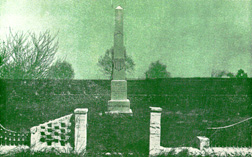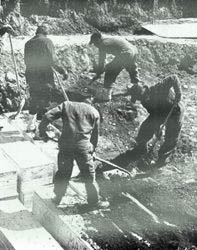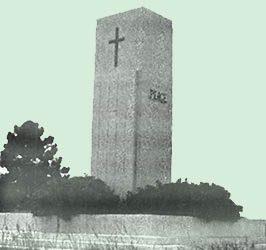|
POTTER'S FIELD
Historical Background
"Then Judas, which had betrayed Him, saw that he was condemned, repented himself, and brought again the thirty pieces of silver to the chief priests . . . and they took counsel, and bought with them the potters' field to bury strangers in." This excerpt from the Gospel of St. Matthew is probably the origin of the name Potter's Field; certainly, even in pre-Biblical times, man felt the obligation to do justice and honor to the dead with proper burial.
 |
There has been much written about the Potter's Field on Hart Island and the involvement of the Department of Correction of the City of New York in this important community activity.
The department's involvement results directly from the Administrative Code of the City of New York, wherein it specifically states that in accordance with ...
"CHAPTER 24
DEPARTMENT OF WELFARE
TITLE A
Section 603-10.0 Potter's Field. - The Commissioner shall have charge of the Potter's Field, and when the necessity therefor shall arise, shall have power to lay out additional Potter's Fields or other public burial places for the poor and strangers....The Potter's Field on Hart's Island, however, shall remain under the control of the Department of Correction, and the burial of deceased paupers therein shall continue under rules and regulations established by the joint action of the Department of Welfare and Correction.... (As amended by L.L. 1942, No. 50, October 29; as amended by L.L. 1953, No. 136, August 5.) "
While many other projected plans are being officially studied for the burial of indigents, this Department in the interim must maintain the present Potter's Field at Hart Island as mandated. While we perform this necessary service for the community, paradoxically, it provides a vocational activity for those inmates voluntarily participating. . . .
George F. McGrath
Commissioner
Department of Correction
(1967)
|
The City of New York has undertaken the responsibility of laying to rest the bodies of those in the City who died indigent or unbefriended, since the early part of the 19th century, when they were interred at Washington Square in Greenwich Village. In 1823, these remains were removed to Fifth Avenue and 40 - 42 Streets, Manhattan. When this site was selected for a reservoir, the remains were again removed to Fourth Avenue and 50th Street, this ground being later granted to the Women's Hospital. In 1857, the remains of 100,000 paupers and strangers were transferred to Ward's Island, 75 acres of which were allocated for this purpose.
The laws of 1868 authorized the Commissioners of the New York City Department of Public Charities and Correction to purchase and take title to any plot of ground, convenient and accessible to the City and large enough for a public cemetery....In the same year, the City of New York acquired Hart Island from John Hunter and son for $75,000. During the yellow fever epidemic of 1870, the southern part housed diseased persons confined to isolation.
Forty-five acres on the northern tip of the hundred-one acre Island were designated as a burial site, or Potter's Field, on April 20, 1869. Louisa Van Slyke, an orphan who died alone in Charity Hospital at the age of 24, became the first to be buried there.
In 1895, the Department...established a Branch Workhouse for aged and infirm men, narcotics addicts, and short-term inmates. In 1905, the Department also established a reformatory at Hart Island for young offenders known as a "Reformatory for Misdemeanants." This was transferred to another location off the Island in order to rectify the lack of segregation between adolescent and adult inmate programs.
In 1941, the bodies of the Civil War veterans who had been buried in the Civil War Cemetery on Hart Island were disinterred and removed to Cypress Hills National Cemetery. After World War II, the Army was allotted 10 acres...to build a Nike base. This was abandoned by the Army on June 30, 1961, and returned to the City.  |
Monument erected by the NYC Army Reserve, on May 10, 1877, in memory oi the Veteran Union Soldiers and Sailors buried at the Civil War Cemetery on Hart Island. The monument still stands on Hart Island, although the remains of these dead were removed to Cypress Hills National Cemetery in 1941. |
In 1950, the Board of Estimate adopted a resolution authorizing the release of Hart Island to the Department of Welfare to be used for the rehabilitation of homeless men, on the assumption that Rikers Island facilities would sufficiently accommodate the steadily increasing inmate population. During the early part of 1954, when increased inmate population made the capacity of housing on Rikers Island inadequate, custody of Hart Island was returned to the Department of Correction.
Departments Involved - Laws
Since 1941, New York State Social Welfare Law No. 141 (now called Social Services Law No. 141, as per 1967 amendment) has made it compulsory for the City to provide for the burial of the dead, or to reimburse friends or relatives of the deceased for the costs of the burial, in whole or in part, if legally responsible relatives of the deceased were not able to do so.
Present laws of the City of New York authorize joint jurisdiction over Potter's Field by the Department of Correction and the Department of Welfare...
Records and Burial Procedure
Any citizen who becomes aware of the death of any person
is required by law to report the death to the local Police precinct, who
notifies the Chief Medical Examiner. If a person dies in a City hospital
or institution, and his body is not claimed within 24 hours from the time
mailing notice of his death is received, the Department of Hospitals is
authorized to allow his burial at Potter's Field.
CREDITS |
| Copy for A Historical Resume of Potter's Field was prepared by Gale Silver, Public Relations Unit, NYC Dept. of Correction, 1967. Photos were by Arthur Aidala, Public Relations Unit; C.O. Cecil Rsamsey, Reception and Classification Center for Men, and freelance photographers Robert E. Hood and Bryan R. Tolbert, 1967.
Printed at the Rikers Island Print Shop Inmate Vocational Training Program, 1967.
Originals are available for viewing in the NY Correction History Society's Research Reading Room. See NYCHS Archives Services web page for details.
|
The body of a deceased pauper is sent to the county morgue of the county in which he dies, and the medical examiner applies to the Board of Health for a burial permit. If the body is unclaimed, the burial permit and the deceased are sent to the central morgue at Bellevue Hospital on East 29 Street, Manhattan.
There, services are said for the deceased...Actually, no one knows the religion of many of the strangers buried in Potter's Field, but the authorities do their best to notify the proper agencies when a member of one of these groups comes to their attention.
At the morgue, the bodies of the deceased are wrapped
in shroud paper and sealed in pine coffins which are lined with waterproof
paper when necessary. Unknowns are fingerprinted and photographed, and
are interred with all their clothes and belongings, so that they can be
identified later. Inside the coffins and on top of them are placed the
duplicate and triplicate, respectively, of the burial certificate, chemically treated so that they are legible even after 25 years.
The bodies of the deceased are then taken to the City
Cemetery at Hart Island via a Department of Hospitals morgue wagon, which
operates twice weekly. It is transported from the Bronx to the Island by
a ferry run by the New York City Department of Marine and Aviation.
The morgue wagon driver is stopped at the entrance to
the Island and checked in by the dock security officer. During the rest
of his drive, along the bumpy country road to the cemetery, he passes fields of high grass and blue asters in the summer. No one else stops him until he reaches the burial site; there are no living persons at Potter's Field except for the inmate burial detail and the correction officers. At the burial site, the driver presents the burial certificates to the officer
in charge. A team of inmates, dressed in gray, remove the coffins and inscribe them with the names of the deceased in indelible crayon.
 |
Concrete section markers indicate the locations of coffins within the trenches. There can be no individual head stones. . . . |
The coffins are placed in trenches 15x4O ft. dug 7 to
8 ft. deep. The adults coffins are piled in stacks of three deep...Although the entire burial ground is consecrated, Catholics were
buried in a separate section prior to 1960....There are no individual tomb stones, but plot and section markers indicate the location of the coffin, by a numerical system.
Necessary data pertaining to the deceased has been recorded in the interment registers since the first burial at Potter's Field. The individual record books now in use contain 400 pages and last for about six months each...The entry for each body includes permit number, section number, plot number, grave number, age of the deceased, date the permit was issued, date of death, cause of death, signature of the medical examiner, place of death, and date of burial. Careful records are also kept of disinterments, of which there are about 150 a year.
There are about 600,000 dead buried at Potter's Field,
approximately two thirds of them infants and stillborn. Of the 8,000 burials a year, 1,500 are infants. Because interments are made on the mass level of approximately 125 a week, there can be no rites said over the dead at the grave sites. Despite the large number of burials, the 45-acre area
of the cemetery is in no danger of being exhausted....
Costs
The cost incurred by the Department of Correction for
the maintenance of the City Cemetery on Hart Island for the year
1966, when forty inmates were assigned to cemetery detail, were as follows:
| ITEM | AMOUNT |
|
Custodial salaries for two correction officers
assigned to cemetery detail | $18,020.00 |
| Food for inmates
(five days per week) | $7,787.52 |
| Clothing for inmates | $4,000.00 |
| Miscellaneous supplies such as chlorinated lime, cement
for ground markers, tools, as well as depreciation for gasoline pump used
for draining graves | $285.55 |
| TOTAL | $30,093.07 |
The cost to the City for the burial of an adult is $75,
and of an infant or fetus, $29. Only half of this amount is reimbursed
by New York State, except in the cases of State charges and Social Security
collectors, for whose burial the City is reimbursed by the State and Federal governments respectively.
 |
The inmates begin to cover the coffins with soil. When the job is completed, ground covering the trench will be level with the background. |
Inmates and Custodial Staff
In 1966, the inmate census decreased sharply as a result
of changes in the penal code, and Hart Island was no longer required for
housing of short term prisoners. Hart Island has been utilized by the Office of the Narcotics Administrator during 1967 as a rehabilitation center for narcotics addicts.
Thirty inmates from the N.Y.C. Reception and Classification Center for Men, who come to Hart Island to work during the day, are charged with burial and upkeep of the entire cemetery at present. Assignments to Hart Island are made on a voluntary basis. Many of the inmates consider work there desirable, because it affords them the opportunity to be in the open air and away from the prison proper, and because it gives them job experience in a well-paying field. They are carefully interviewed to ascertain that they can perform these services without becoming emotionally upset.
The inmates remove the coffins from the morgue wagon and
inter them, make road repairs, spray the ground to control vermin infestation, and take charge of the general upkeep. Six of the inmates disinter the remains on occasions when it becomes necessary to do so.
On one such occasion, a man had been buried for...years, when his son suddenly hit oil millions and wanted to give his father a private burial. Another time, an unknown buried there was later found
to be an American veteran of World War 1. Until shortly before his death,
he had sent small donations to a group of French nuns who had nursed him
back to health during the war. When his letters and contributions stopped
coming, the nuns investigated to find out what had happened to him. They
learned that he had died penniless and been buried here. They paid to have
his remains brought to France and buried in their convent....
 |
The above monument was erected by inmate volunteers of the department in memory of the communities indigent buried in Potter's Field. |
Inmates Pay Tribute to
Unbefriended and Indigent Dead
Because of the massive number of interments made at Potter's Field weekly and the great expense to the City, burials must be un-elaborate. Primarily, those interred on Hart Island are not vagrants and alcoholics from Skid Row, as hearsay has it, but people who worked hard during their lifetimes just to "keep their heads above water," and could not afford the expenses of private funerals.
The inmates on Hart Island, many of whom are without friends and families, appealed to the Warden and offered to build a monument to the unbefriended dead. This was accomplished in 1948 when, in cooperation with the custodial staff, they erected a 30-foot high monument in the center of the burial site. On one side is engraved a simple cross, on the other the word "Peace."
|






